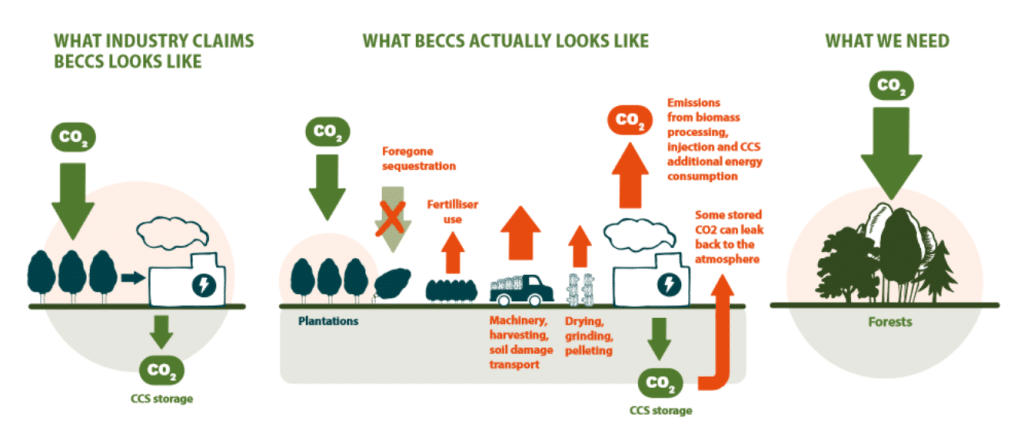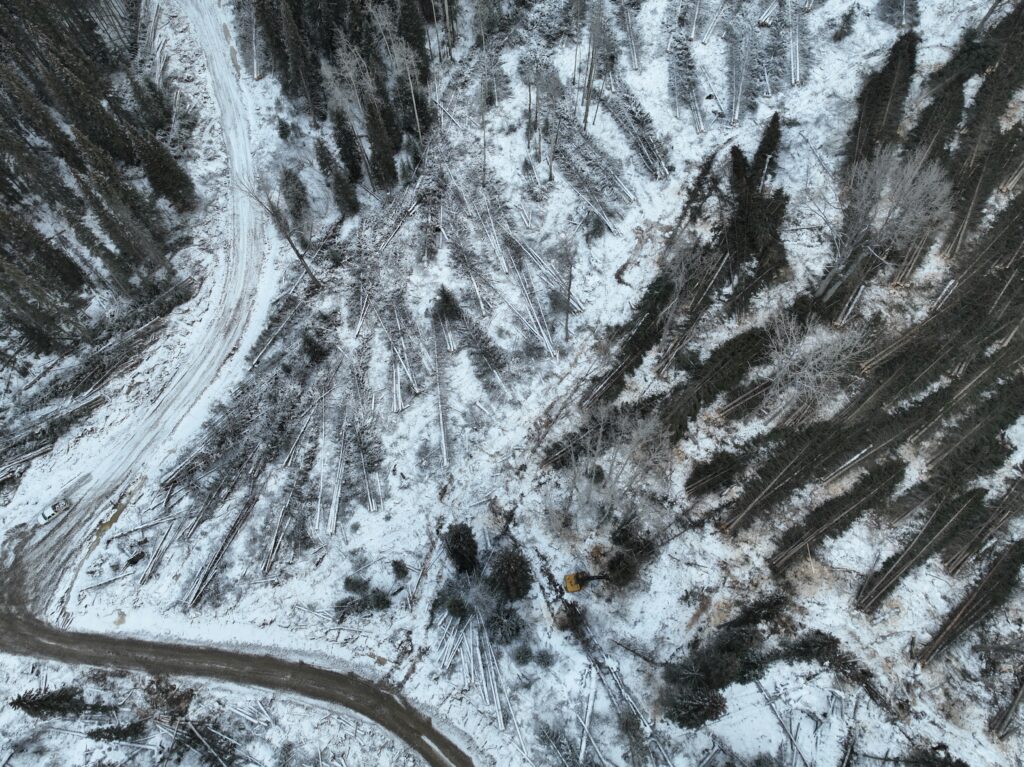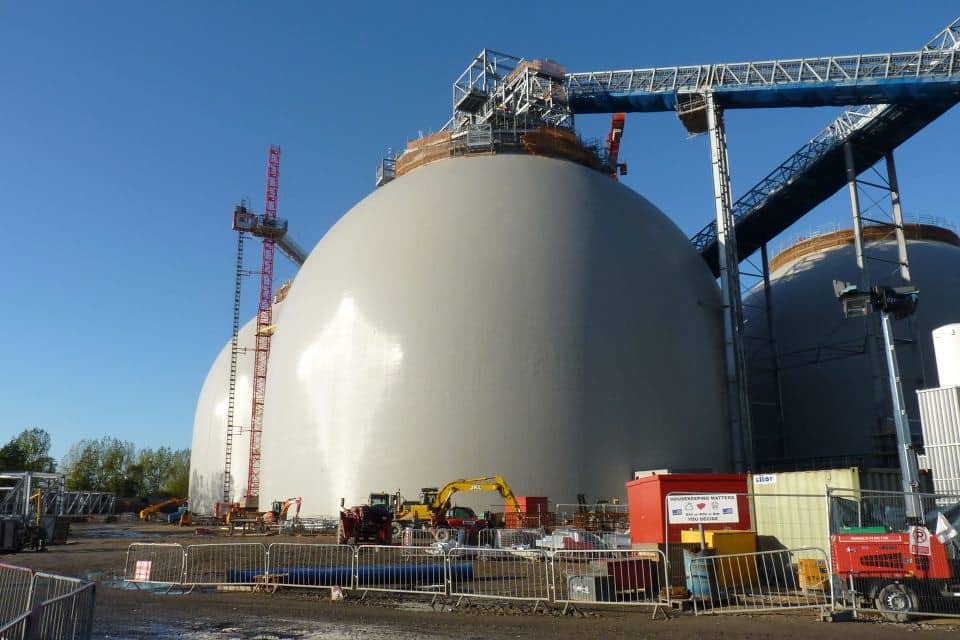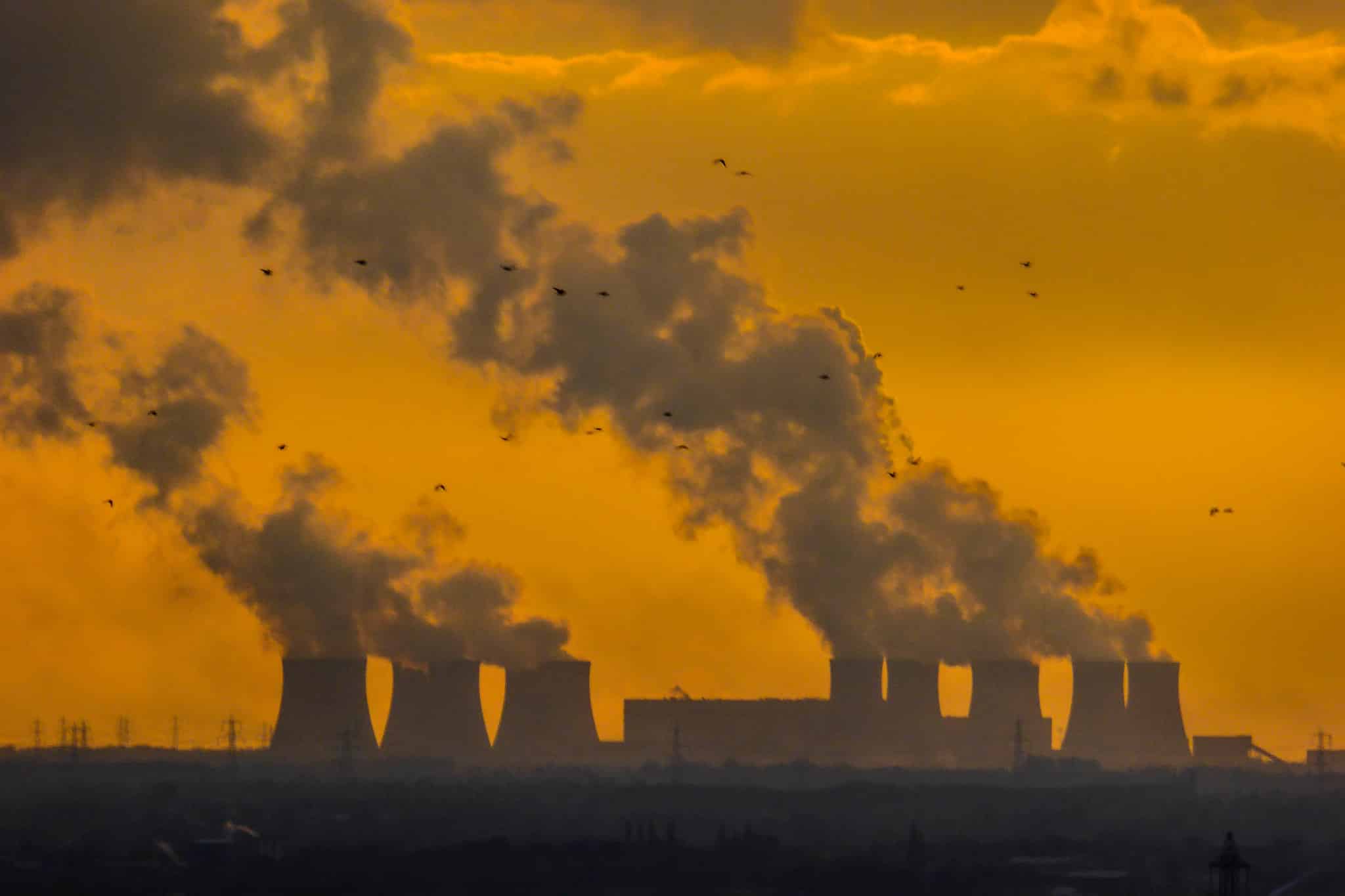Guest article by Katy Brown, bioenergy campaigner with Biofuelwatch
Earlier this year the UK Secretary of State Claire Coutinho granted development consent for Drax’s Bioenergy with Carbon Capture and Storage project at its Selby power plant. Almost simultaneously, the government published a consultation with proposals for extending subsidies for continued biomass burning for electricity generation without carbon capture.
What is BECCS?
BECCS stands for Bioenergy with Carbon Capture and Storage, though in Drax’s case what they have actually asked for consent for is “BECC” (without the S for storage) as they are not proposing to store the carbon, only capture it. The idea is similar to that of Carbon Capture and Storage (CCS) with fossil fuels, where the carbon that is emitted when the fuel is burnt is captured at the source through a chemical scrubbing process and then transported to undersea or underground geological storage sites.
The difference with BECCS is that—in a quite incredible carbon accounting sleight of hand—because Drax classes the ‘biogenic’ carbon emitted when it burns wood as ‘carbon neutral’, the company argues it can capture carbon (which it claims not to emit), and achieve ‘carbon negativity’. These pie in the sky carbon capture claims would be simply laughable if they weren’t being taken seriously by policymakers and applied to future carbon budgets. Capturing carbon through BECCS in the future is being relied upon to allow business-as-usual fossil fuel burning now, which isn’t funny at all.

How it works (or doesn’t)
Drax’s BECCS plan is the first of its kind in the world, and the company claims it will capture 95% of CO2 emitted. The world’s only operating commercial carbon capture facility at a coal-fired power plant (coal being another solid fuel thus giving the best available comparison), is Boundary Dam, in Canada. The carbon capture rate there in 2021 was less than 37% of the official target of 90%. The carbon capture rate at the plant deteriorated in 2021 by 43% compared to the previous year according to data from Sask Power, the Canadian utility company operating the project. The plant’s performance is so far short of its original target the company has now revised its carbon capture target downward to just 65%. The poor performance at Boundary Dam is a strong indication that Drax’s expected carbon capture rate from BECCS is highly implausible.
Other large-scale CCS projects globally have also failed to meet projected capture targets. One of the largest gas projects in the world, the Gorgon LNG project of Western Australia, has under-performed against its targets for the first five years of operation by about 50%, and revealed last year that it was running at just a third of its planned capacity. A Global Witness study found that over a five-year period, Quest, a Shell blue hydrogen project in Canada, captured 48% of emitted GHG, falling woefully short of its projected 90% carbon capture rate. This rate dropped to only 39% when including other greenhouse gas emissions from the project.
While there have been decades of research and development into carbon capture from coal power stations, albeit with very little operational experience, BECCS has never been demonstrated to work at scale at all. Drax has previously admitted in written correspondence with Biofuelwatch that its assumptions about BECCS performance are not based on real-world trials. This suggests that the technology is far from ready for implementation, and therefore unlikely to help Drax meet its “ambitions to be a carbon negative company by 2030.” On top of this, the carbon capture process proposed involves an amine solvent, the exact composition of which is not in the public domain due to ‘commercial confidentiality’. What is known however is that amine degradation products that result from the carbon capture process—nitrosamines in particular—are carcinogenic.
Continuing forest destruction around the world
Assuming that BECCS works (it won’t, and certainly not at the capture rates Drax is claiming it will achieve) this does nothing to address the harmful impacts of biomass sourcing around the world, and in fact due to the ‘energy penalty’ incurred due to the energy required for the carbon capture process to work, would significantly reduce Drax’s electricity output. Based on Drax’s own figures, its BECCS plans would remove 371 MW net electrical capacity from the grid. If Drax were to run at maximum capacity, and biomass electricity with BECCS is more widely adopted, this will lead to more trees being destroyed per unit of electricity produced, with the associated loss of forest, biodiversity and forest carbon sequestration.
Drax caught sourcing from rare old growth forests, again
Drax has recently been caught out yet again by another exposé of its activities in Canada revealing that the company is continuing to source feedstock for manufacturing wood pellets from some of Canada’s rarest old growth forests. This comes a year and a half after a 2022 Panorama investigation exposed Drax’s involvement in the same practices. As the National Audit Office concluded in its recent report into biomass, the government has not evaluated whether the current arrangements provide adequate assurance that firms are complying with sustainability requirements—the above is clear evidence that they aren’t.

As Michelle Connolly of Canadian organisation Conservation North, which worked on the recent investigation says, “Hundreds of animals and plants in British Colombia are teetering on the edge of extinction because of a century of industrially logging their habitats. Building a machine that sucks carbon out of the sky does absolutely nothing to bring their homes back. Artificial carbon capture is yet another example of the technological fetish which got us into this mess in the first place. For Earth’s biodiversity and carbon cycle to function we need to leave natural forests alone.”
Community impacts
BECCS will similarly do nothing to help ameliorate the horrific health impacts on the communities that live near existing Drax pellet mills in the Southern US. These are often Environmental Justice communities, i.e. poor majority black communities, who suffer from the toxic wood dust emitted.
Katherine Egland, Chair of Environmental and Climate Justice Committee of the National Association for the Advancement of Colored People, explains that “Bioenergy Carbon Capture and Storage (BECCS) is yet another corporate greenwashing scheme—rooted in greed—to compound one flawed, expensive energy technology with another. Carbon capture sequestration or storage is an unproven, cost prohibitive, and dangerous technology that will not effectively remove or neutralise carbon, but will pose significant threats to human health and safety resulting from the possibility of pipeline ruptures, or the incineration or combustible processes that emit particulate matter which can contain heavy metals like lead, mercury, cadmium, and arsenic. Not only will our planet suffer and continue to warm, but the most vulnerable populations that have already disproportionately endured the brunt of climate change, will once again be subjected to the disparate environmental effects of the use of these risky technologies.”
Continued subsidies for continued unabated business-as-usual biomass burning
Drax’s application for capturing carbon at its biomass facility does not concern itself with transport and storage aspects, a worry in itself as Drax has lobbied for continued subsidies for biomass burning which are decoupled from subsidies for capturing carbon. Based on its recent consultation, the UK government looks keen to oblige, given it was inviting applications for such subsidies as part of the consultation rather than awaiting the outcome. It would seem that Drax’s BECCS plans are more about capturing subsidies than carbon—think tank Ember predicts Drax’s BECCS plans will require £31.7 billion in subsidies.

Underground storage concerns
If larger amounts of carbon are ever captured at Drax, there are significant concerns regarding both the timeline within which the necessary infrastructure will be built, and the viability of underground storage. For example, Drax depends on the completion of the the Humber Low Carbon Pipelines project to pipe its CO2 away from the power station and into undersea storage sites, but National Grid (which owns and operates electricity and natural gas transmission networks in the UK) pulled out of the project last year and has withdrawn its application for development consent. Instead, National Grid will focus on electricity infrastructure and upgrade this to deal with the increased demand from wind farms, EVs and heat pumps. The Institute for Energy Economics and Financial Analysis has also reported on leaking carbon dioxide in Norway’s Sleipner and Snøhvit underground geological storage sites, which are widely cited as proof of the technology’s viability. The unexpected subsurface geology developments in the two projects doesn’t just cast doubt on Drax’s plans, it calls into question all offshore CO2 storage ambitions globally.
We need to stop destroying forests and reduce emissions now
The world already has highly effective carbon capture technology up and running—trees sequester carbon through photosynthesis, without requiring harmful chemicals or millions of pounds in subsidies. Burning millions of tonnes of imported wood to generate electricity is wasteful, inefficient, harms biodiversity and human health, and accelerates climate change. There is growing scientific consensus that burning woody biomass in power stations is not ‘carbon neutral’—the decades-long carbon payback period associated with using woody biomass as a fuel for power generation is incompatible with the need to reduce emissions before 2030 to safeguard the Paris Agreement’s 1.5°C temperature rise threshold target.
BECCS is being put forward simply to keep carbon fuel burners of all kinds in business, and is a dangerous distraction from genuine climate solutions: we need to reduce emissions and stop burning carbon fuel of all kinds for electricity now.



